Inquiry-based learning has been getting a lot of attention lately for student engagement and developing 21st Century skills. Rather than being filled with teacher lectures, students are doing the research and driving the instruction. A lot of schools are adopting PBL to embrace this type of learning in the classroom. This acronym can mean Project-Based Learning or Problem-Based Learning, but regardless of how you define the acronym, the process is very similar. Students are conducting research to help them solve a real-world problem by either sharing their learning with an audience or ending with a project that highlights their learning.
Being a primary teacher in my third year of PBL, I had found it difficult to really assess what my students knew and how to help them in their research process.
Since they are developing readers, a lot of sources would be too difficult. I felt that a lot of the learning in PBL was still very teacher driven, rather than the students being in control of the path of learning. I knew that as year two wrapped up I needed to switch up the way I would begin a PBL unit to better help my students with their inquiry.
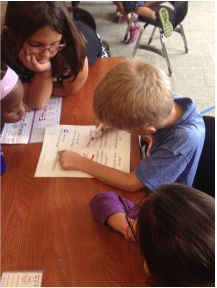 I discovered Question Formulation Technique on Twitter during a chat right after the school year started and we were just started a PBL unit on Leadership. Once I saw the title Make Just One Change: Teach Students to Ask Their Own Questions, I knew that it was a book that I needed to check out and try to implement in my classroom. As I read through the book, I noticed that a lot of examples were for upper grades, but that has never shied me away from trying things in my classroom.
I discovered Question Formulation Technique on Twitter during a chat right after the school year started and we were just started a PBL unit on Leadership. Once I saw the title Make Just One Change: Teach Students to Ask Their Own Questions, I knew that it was a book that I needed to check out and try to implement in my classroom. As I read through the book, I noticed that a lot of examples were for upper grades, but that has never shied me away from trying things in my classroom.
For those not familiar with PBL, most units start out with some type of entry event. It can come as a speaker, field trip, or other type of activity to get students talking and excited about what they will explore in the coming weeks. Following the entry event, it is important to give students the driving question. Once students have been told the Driving Question, the teacher thing follows up by asking students what are their “Essential Questions” that would help them in their inquiry process. When it comes to the Driving Question, it can sometimes be worded in a way that is a little challenging for primary aged students. With this being a challenge, having students come up with questions can be a problem causing a lot of silence in the classroom.
To help solve this problem, I tried out the Question Formulation Technique. I told students the Driving Question after the Entry Event, but waited until the next day for them to generate questions. The following day I changed the Driving Question into a statement that would now become our Question Focus.
I had no idea what would be the result, but knew from the prior starts to PBLs that something needed to change.
Being a primary teacher, I knew that I would not be able to go through the whole process in a day. Since it was their first exposure to it in the classroom, I decided to make each part its own day. I broke up the QFT process because primary-aged students need explicit instruction and prompting to be successful.
As I showed students the QFocus, I then displayed the four rules and read them aloud. Instead of having students go into groups to generate the questions like the book suggested, I decided to do it whole group. My reasoning behind this is that I wanted them to build upon each other’s question as a class, but also because it is difficult for them to spell at such a young age.
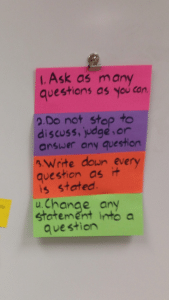
The questions started to come in slowly. There were some long pauses and after so long, I would repeat “What are you wondering when you hear…?” The questions then started to pick up and more hands went into the air. Students were asking some great questions like:
“What change do leaders create?”
“What do leaders do in their life?”
“Do people serve other people?”
“What do you have to do to create change?”
Then students started asking,
“What is a pencil?”
“What is a hamburger?”
This was a little frustrating, but I had to remind myself of Rule 2: Do not discuss, judge or answer any questions. To help with this, I kept on repeating the QFocus. Eventually we got back on track and generated a good number of questions that could help us the rest of the QFT. Overall, I was very impressed with the number and types of questions that were generated throughout that time.
As their teacher I had a better understanding of how I could help them in their inquiry because I was already hearing great discussions among them.
Following students generating questions, I typed up each of the questions for the next part in QFT. We had our conversation about open and closed questions, which aligned perfectly with our questioning unit in literacy. After the overview, students went out into groups for four to five and began to classify the questions. It was interesting to hear their discussions because students had different opinions on the classifications and were defending their answers. After groups had classified them with a C or an O, we had our discussion about the advantages and disadvantages of each type of question. This was the part of the QFT process that really blew me away. While we had not spent a lot of time on questioning, their advantages and disadvantages for each type of question were really a highlight of the process.
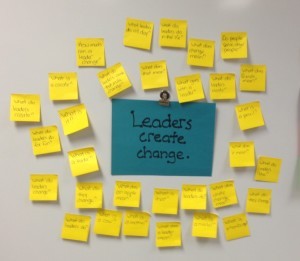
Prioritizing questions was a great way to help focus the direction of our their inquiry, which is why I now do QFT with any PBL. To prioritize the questions, I had the students use the same papers from the day before and gave them a marker. They either circled questions as a potential top 3 or put a big “X” through the question. Once each group had their top 3 questions, we came back together as a group. We displayed the top three questions from each group and then had a class discussion to decide which would be our three questions that we use as a class. Students began to defend their questions and we even had some debates. It was great to see students defend their responses and share how it and how it would guide the classroom learning.
Following the QFT, my students were more excited about the PBL unit because they already generated so many questions, had good discussions with their peers, and had a better sense of direction as what would guide their inquiry. As their teacher I had a better understanding of how I could help them in their inquiry because I was already hearing great discussions among them. I had a better direction for which questions to help them answer first. Having this direction gave me a clearer path of how to proceed for the rest of the PBL unit.
For primary teachers, new or experienced with PBL, giving QFT a chance would benefit their students and classroom environment. Not only are they generating focused questions, which can be a challenge with young students, but the discussions with peers helps them in their preparation for a successful PBL.
 Mitch Mosbey teaches first grade and is lead teacher for technology at Promise Road Elementary in Noblesville, Indiana. He graduated from Indiana University School of Education in Indianapolis. Besides teaching, he is very involved in and passionate about educational technology.
Mitch Mosbey teaches first grade and is lead teacher for technology at Promise Road Elementary in Noblesville, Indiana. He graduated from Indiana University School of Education in Indianapolis. Besides teaching, he is very involved in and passionate about educational technology.
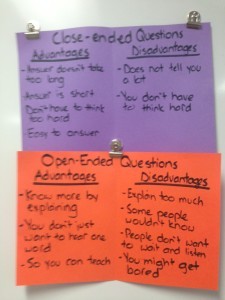



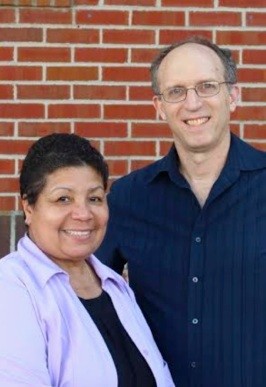
lovely story. Sounds like a great way to enhance the kids engagement and learning. I really like the dip into the very mundane, ‘what’s a hamburger?’ Some kids may have needed a break to more deeply understand what you were asking of them, and this is how they took that break. They didn’t check out, but continued being engaged in the way that they could to slow things down so they could understand? Who knows, but I think those questions may have been an important part of the process for the kids asking them.
As a second grade teacher I empathize with your situation. I wondered how second graders would ever be able to focus long enough to get through a QFT. I agree that breaking down the steps helps a great deal. We just started a science unit on matter and the students started their PBL with an investigation of objects spread out on a lab tray. They had to observe these objects and decide how they would place them into categories. They found that they could group the objects by color, size, shape, texture, and use. They also found out that all of the items could fit into more than one group. Their discovery of these properties led to our main inquiry..”Everything in this world is made up of matter”. Day 2: I gave them the rules of the QFT and timed them with about 7 minutes to come up with as many questions as they could individually. Wow! I was given the best questions ever! We followed the rules of not discussing the questions, and also writing them down exactly how they stated them. The kids helped me change the statements into questions and then we read all of them again. They were amazed at their own questions. Day 3: The students have been working on making a bubble map of how different things we know about matter are related.
We have yet to get to the open and closed question part, but I know they will do a terrific job separating the questions. The kids are already completely engaged and ready to learn everything they can about matter. This is a very powerful teaching tool!
Hello,
I am having a hard time getting started with the QFT in my classroom. I teach first grade. It seems as though I get stuck right after QFocus and recording the questioning. We have to do everything whole group so the process then becomes overwhelming. Any help with streamlining the process so that we can move through the entire protocol would be greatly appreciated.
I am an elementary ed major doing a little assignment on PBL and I really loved your blog. It helped answer a few questions that I had, that were a little confusing to me. I loved the information about PBL being a little difficult for younger grades as they have a hard time formulating the questions, and found the QFT to be very interesting. Thanks!
I am a education major, and I enjoyed your post. There is a lot that I am learning about PBL, and I enjoyed the part about the focus questions and class discussion. As a future educator facilitating appropriate class discussion is a hope and goal of mine. Seeing that it is helpful as a part of PBL, it is vial as a future educator that I understand how to properly facilitate and structure discussion in the classroom.